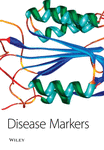Poly Thymidine Polymorphism and Cystic Fibrosis in a Non-Caucasian Population
Abstract
Background: Cystic fibrosis is a monogenic recessive disorder found predominantly in Caucasian population. This disease arises from mutations in the cystic fibrosis transmembrane conductance regulator (CFTR) gene. In this study we consider poly T polymorphism c.1210-12T[5], c.1210-12T[7], c.1210-12T[9] (T5, T7, T9) in the intron 8 of CFTR gene in normal individuals and cystic fibrosis patients in the north of Iran.
Material and methods: 40 CF patients and 40 normal individuals were screened for poly T polymorphism in intron 8 of CFTR gene using Reverse Dot Blot method which was also used to detect p.Phe508del among CF patients.
Results: T7 allele is the most prevalent in both normal and CF patients. Its abundance is approximately 75%. T9 and T5 represent approximately 20% and 5% of alleles respectively. T7/ T7 genotype is the most present in both normal and CF patients with 72.5% and 60% prevalence respectively. p.Phe508del was present in 13 CFTR alleles belonging to 7 patients with either homozygote T9/ T9, T7/ T7 or compound heterozygote T7/ T9 genotypes.
Conclusion: Contrary to the Caucasians, T7 allele is more frequent in Northern Iranian CF patients. The presence of p.Phe508del and T7 allele in the same framework is reported for the first time in this part of the world. Further investigations of other populations will help to understand whether p.Phe508del arose by selection pressure in this part of the world or was imported from European countries. The abundance of T5, T7, T9 alleles indicates that this polymorphism can be used as one of the informative markers for detection of normal and mutant alleles in prenatal diagnosis or carrier assessment in families with previous history of the disease in regions with high degree of CFTR mutation heterogeneity.




